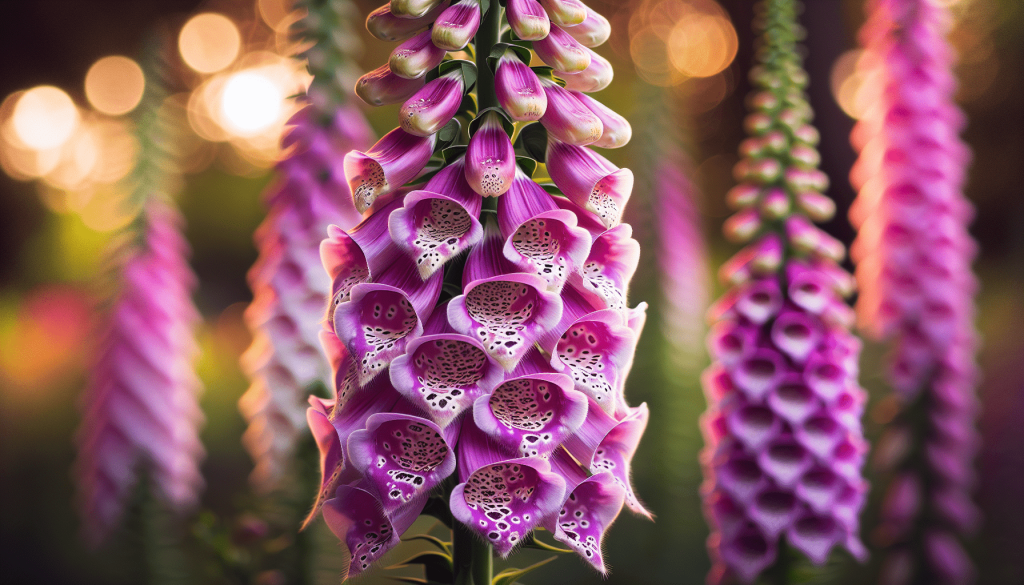This post may contain affiliate links. As an Amazon Associate, we may earn commissions from qualifying purchases.
In the lush landscapes of the United Kingdom, you’ll often come across the strikingly beautiful yet perilous foxglove, known scientifically as Digitalis purpurea. This plant, cherished for its tall flower spikes adorned with vibrant purple blooms, thrives in the temperate climate and varied habitats of the region. While the foxglove adds a touch of natural elegance to gardens and wild spaces, it carries a hidden danger due to its toxic properties. Both enchanting and hazardous, the foxglove exemplifies the delicate balance within nature, where beauty can sometimes mask potential threats. Have you ever strolled through a beautiful garden or a peaceful woodland area and come across an elegant plant with tall spikes of tubular, bell-shaped flowers? If you have, there’s a good chance you’ve encountered the foxglove, scientifically known as Digitalis purpurea. Commonly found in the United Kingdom and beyond, this plant is not only known for its striking appearance but also for its potential toxicity.
Understanding Foxglove (Digitalis Purpurea)
Foxglove, or Digitalis purpurea, is a biennial plant that is native to Europe but has been widely spread to other parts of the globe. Its name, foxglove, might evoke visions of woodland creatures wearing the flowers like mittens, but there’s far more to this plant than its whimsical name.
Plant Characteristics
The foxglove is notable for its tall, slender stems that can grow up to six feet tall. It produces a rosette of large, oval leaves at its base in the first year, and in the second year, it sends up towering flower spikes covered in tubular blooms.
| Feature | Description |
|---|---|
| Height | Up to 6 feet |
| Flower Shape | Tubular, bell-shaped |
| Flower Colors | Often purples, pinks, and whites |
| Growth Pattern | Biennial (flowers in the second year) |
Habitat and Distribution
Foxglove thrives in a variety of habitats across the UK. You’ll often find it in woodlands, along hedgerows, in meadows, and sometimes even in gardens. Its ability to adapt to different environments has enabled its widespread presence.
Historical and Medicinal Uses
Folklore and Mythology
Foxglove has a rich history in folklore. It has been associated with fairies, witches, and various myths throughout European cultures. In some tales, foxgloves were believed to be the source of fairy dust, while in others, they were thought to be cursed, leading to bad luck if brought indoors.
Medical Significance
Interestingly, Digitalis purpurea is the source of digitalis, a compound used in heart medication. Despite its toxicity, digitalis derivatives have saved countless lives by treating heart conditions. The plant’s medicinal properties were discovered in the 18th century, revolutionizing the treatment of heart disease.
| Use | Description |
|---|---|
| Folklore | Associated with fairies and witches |
| Medicinal | Source of digitalis, used in heart medication |

Identifying Foxglove
Appearance
Pinpointing a foxglove is usually straightforward, thanks to its distinctive features. The tubular, pendulous flowers are densely packed along the upper part of a tall spike, ranging in colors from rich purples and pinks to pristine whites. Each flower is generally about 1–2 inches long, with speckled throats adding to their charm.
Leaf Structure
The basal leaves of the foxglove are oval and can be quite large, with a downy texture. These leaves grow in a rosette pattern during the plant’s first year. In the second year, the plant produces a stem with smaller, lance-shaped leaves along its length.
| Feature | Description |
|---|---|
| Flower Length | 1-2 inches |
| Leaf Texture | Downy |
| Leaf Arrangement | Rosette in the first year, stem leaves in the second |
Potential Dangers and Toxicity
Poisonous Compounds
Foxglove contains several toxic compounds, including digoxin and digitoxin. These substances can cause significant health issues if ingested, affecting the heart’s ability to function properly. Symptoms of foxglove poisoning include nausea, vomiting, diarrhea, and severe heart irregularities, which can be fatal.
Risks to Humans and Animals
Both humans and animals are at risk from foxglove toxicity. Children and pets are particularly vulnerable due to their curiosity and tendency to explore their environments with their mouths.
| Risk | Description |
|---|---|
| Poisonous Compounds | Digoxin, digitoxin |
| Symptoms | Nausea, vomiting, diarrhea, heart irregularities |
| Vulnerable Groups | Children, pets |

Cultivation and Care
Growing Conditions
Despite its toxic nature, foxglove is often cultivated for its beauty. It prefers well-drained soil and partial shade but can tolerate full sun in cooler climates. The plant is quite hardy and can grow in various soil types, making it a versatile addition to gardens.
Planting Tips
If you decide to cultivate foxglove, it is essential to handle it carefully. Wear gloves when planting or handling the plant to avoid skin irritation. Also, ensure that it is planted away from areas accessible to children and pets.
| Factor | Preferred Conditions |
|---|---|
| Soil | Well-drained, various types |
| Light | Partial shade to full sun |
| Safety Precautions | Wear gloves, plant away from children and pets |
Ecological Importance
Role in Ecosystems
Foxglove plays a role in supporting local ecosystems. The plant is a valuable source of nectar for bees and other pollinators, contributing to the overall health of the environment. Its presence in diverse habitats also underscores the importance of conservation efforts to maintain biodiversity.
Attracting Pollinators
Bees, in particular, are attracted to the bright, tubular flowers of the foxglove. The speckled throats of the flowers guide these pollinators, ensuring the plant’s reproductive success and helping to sustain the bee population.
| Ecological Role | Description |
|---|---|
| Pollinator Support | Provides nectar for bees and other insects |
| Habitat Importance | Contributes to biodiversity |
Conservation Efforts
Protecting Native Species
Given its widespread distribution and ecological significance, efforts to protect and conserve foxglove populations are crucial. Conservation programs often focus on preserving natural habitats and preventing overharvesting of wild plants.
Public Awareness
Increasing public awareness about the foxglove’s dual nature—its beauty and toxicity—can help mitigate risks while promoting appreciation for this plant. Educational campaigns and community involvement are keys to successful conservation efforts.
| Conservation Efforts | Description |
|---|---|
| Habitat Protection | Preserving natural environments |
| Public Awareness | Educational campaigns about benefits and risks |
Foxglove in the Garden
Design and Aesthetics
For those looking to add a touch of elegance to their gardens, foxglove can be a stunning choice. Its tall, striking flower spikes can create a focal point and add vertical interest. Pairing foxglove with other plants that thrive in similar conditions can enhance your garden’s overall diversity and appeal.
Companion Planting
Foxglove pairs well with plants like ferns, hostas, and other shade-loving species. These combinations can create lush, multi-layered garden beds that are both visually appealing and beneficial for local wildlife.
| Garden Design | Description |
|---|---|
| Aesthetic Appeal | Tall spikes add vertical interest and elegance |
| Companion Plants | Ferns, hostas, shade-loving species |
Handling and Safety Precautions
Safe Handling
If you choose to grow foxglove, follow safety precautions to minimize risk. Always wear gloves when handling the plant, and wash your hands thoroughly afterward. Educate children about the dangers of the plant and keep them away from it.
Emergency Response
In case of accidental ingestion, seek immediate medical attention. Knowing how to identify symptoms of foxglove poisoning can be crucial in such situations.
| Safety Tip | Description |
|---|---|
| Handling | Wear gloves, wash hands after contact |
| Emergency Response | Seek medical help if ingested, know symptoms |
Fun Facts and Trivia
Fascinating Tidbits
Did you know that the name “foxglove” is believed to have originated from the Old English “foxes glofa,” referring to the shape of the flowers like gloves for a fox’s paws? Or that foxgloves are featured prominently in many classic paintings and literature?
Pop Culture References
Foxgloves have made their way into various forms of media. From literature to TV shows, these plants have been symbolized in different ways, often highlighting their mysterious and dual nature.
| Fun Facts | Description |
|---|---|
| Origin of Name | “Foxes glofa” – resembling gloves for a fox |
| Pop Culture | Featured in literature, art, TV shows |
Conclusion
The foxglove, or Digitalis purpurea, is a plant of beauty, mystique, and complexity. While its tall spikes of colorful flowers can add charm to any landscape, its potent toxicity calls for careful handling and respect. Understanding its characteristics, history, and role in ecosystems can help you appreciate this plant while safeguarding your well-being and that of others around you.
By being informed and observant, you can enjoy the elegance of the foxglove while navigating its potential dangers responsibly. Whether you encounter it in the wild or cultivate it in your garden, the foxglove remains a fascinating example of nature’s duality, offering both aesthetic wonder and a reminder of the importance of awareness and caution.







